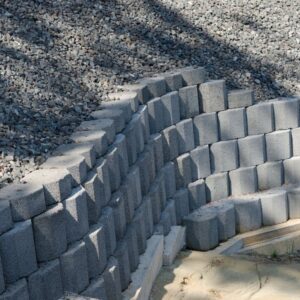- Blog
Maximizing Space and Adding Value with Thoughtful Walkways and Stairs

Creating functional spaces that maximize every inch is a true art in architecture and design. One often overlooked aspect of space optimization is the thoughtful planning and design of walkways and stairs. These elements not only provide practical pathways but can potentially add significant value to a property. By carefully considering the layout, materials, and aesthetics of walkways and stairs, homeowners and designers can create visually appealing spaces that enhance a property’s functionality and overall appeal. This blog post will explore strategies and ideas for maximizing space and adding value through the thoughtful design of walkways and stairs.
Benefits of Well-Designed Walkways and Stairs
Well-designed walkways and stairs can bring numerous benefits to a property. They not only enhance the overall aesthetic appeal of the space and provide practical functions that make it easier and safer for people to move around.
One key benefit is safety. A well-designed walkway or staircase can significantly reduce the risk of slips, trips, and falls. This is especially important in areas with uneven terrain or where water or other hazards are present. Providing clear pathways and non-slip surfaces makes people less likely to have accidents.
Another benefit is accessibility. Well-designed walkways and stairs can make navigating the space easier for people with mobility challenges. For example, ramps can be added to walkways for wheelchairs or walkers, and handrails can be installed on stairs to provide stability and support.
Choosing the Right Material for Your Walkway
When choosing the suitable material for your walkway, several factors must be considered, including durability, aesthetics, maintenance requirements, cost, and climate suitability. Here are some popular options to help you make an informed decision:
Concrete
Concrete is a versatile and durable material that can be poured into various shapes and finishes. It’s low-maintenance, long-lasting, and can withstand heavy foot traffic. Concrete can be plain, stamped, or stained to mimic the appearance of other materials.
Brick
Brick walkways offer a classic and timeless look. They are durable, slip-resistant, and can withstand various weather conditions. Brick pavers are available in different colors, sizes, and patterns, allowing creative design options. However, they may require occasional maintenance like weed control and resealing.
Natural Stone
Stone walkways provide a natural and elegant appearance. Options like flagstone, slate, and granite offer unique textures and colors. Natural stone is durable and can last for many years. However, it can be more expensive than other materials and require periodic sealing and maintenance.
Pavers
Concrete or stone pavers are individual units arranged in various patterns. They come in a wide range of colors, shapes, and sizes, providing versatility in design. Pavers are durable, easy to replace if damaged, and allow for better drainage than solid surfaces. Regular maintenance includes occasional cleaning and re-leveling of any sunken pavers.
Gravel
Gravel walkways are cost-effective, easy to install, and provide good drainage. They are suitable for informal or rustic settings and can be combined with other materials like stepping stones. However, gravel requires periodic replenishment and may be better for areas with heavy foot traffic or wheeled equipment.
Wood
Wooden walkways create a warm and natural aesthetic. They are suitable for garden paths and areas with a softer ambiance. However, wood requires regular maintenance, including sealing, staining, and protection against moisture, rot, and pests.
Landscaping Tips for Walkways
A beautiful walkway can add charm and character to any landscape. Here are some tips for creating the perfect walkway for your outdoor space:
- Choose the suitable material: There are a variety of materials you can choose from, including concrete, pavers, and natural stone. Consider the style of your home and landscape when selecting a material.
- Keep it safe: Ensure your walkway is well-lit and level to prevent tripping hazards. Also, consider adding non-slip materials to prevent slipping in wet conditions.
- Add some curves: Straight paths can be tedious. Adding curves to your walkway design can create visual interest and make your outdoor space feel more dynamic.
- Incorporate plants: Adding plants or flowers along your walkway can enhance your landscape’s overall look and feel. Choose plants that fit your climate, soil type, and personal taste.
- Consider the size: Make sure your walkway is wide enough to accommodate people walking side-by-side. The ideal width is 4-5 feet, but it may need to be more expansive if you have mobility needs or plan to use a stroller or wheelchair.
- drainage plan: Proper drainage is essential to prevent water from pooling on your walkway. If you live in an area with heavy rainfall, consider adding drainage solutions such as French drains or permeable pavers.
- Maintenance matters: Remember that different materials require different maintenance levels.
- Regularly sweeping and power washing your walkway can help keep it looking clean and vibrant. Seal any porous materials to prevent stains and damage from harsh weather conditions. By following these tips, you can create a beautiful and functional walkway, adding value and charm to your outdoor space for years to come.
Using Pebbles and Mulch in Your Walkway Design
Pebbles and mulch can enhance your walkway design by adding texture, visual interest, and practical benefits like improved drainage and weed prevention. Natural-looking pebbles and gravel come in various colors and sizes for a unique personalized design. Mulch retains moisture, regulates soil temperature, and reduces erosion. Complement your surrounding landscape by choosing materials that blend well with existing features, such as natural-colored pebbles or wood chips when surrounded by greenery.
When designing your walkway, it’s essential to consider both aesthetic appeal and functionality. Pebbles and mulch are two materials that can provide both. Pebbles add texture and visual interest and improve drainage by allowing water to seep through the gaps between them. They come in different colors and sizes, giving you plenty of options to create a one-of-a-kind design. On the other hand, mulch is an excellent choice for retaining moisture in the soil, regulating soil temperature, and preventing erosion. It’s also great at suppressing weeds from growing around your walkway.

Conclusion
Walkways and stairs are not just functional features but add value and beauty to your property. From maximizing space with walkways to adding curb appeal with a beautiful entryway, there are many ways to incorporate these elements into your landscape design. Whether you install pavers, use gravel or cobblestone, or create a wooden walkway in your yard, At Delton Concrete Solutions, we offer a wide range of materials to help you achieve the look and function you desire for your walkway and staircase.

Our Latest Post

Enhance Your Home’s Curb Appeal with Concrete Driveways in Deltona
Home Blog Enhance Your Home’s Curb Appeal with Concrete Driveways in Deltona Home Blog A well-maintained and visually appealing driveway can instantly elevate the curb

Choosing the Right Concrete Contractor in Deltona: Key Considerations
Home Blog Choosing the Right Concrete Contractor in Deltona: Key Considerations Home Blog CALL +1 689 219 8424 CALL +1 689 219 8424 Deltona, Florida,

Upgrade Your Pool Deck with Stamped Concrete Finishes
Home Blog Upgrade Your Pool Deck with Stamped Concrete Finishes CALL +1 689 219 8424 CALL +1 689 219 8424 The pool deck is often

Upgrade Your Home’s Exterior with Concrete Driveways in Deltona, FL
Home Blog Upgrade Your Home’s Exterior with Concrete Driveways in Deltona, FL CALL +1 689 219 8424 CALL +1 689 219 8424 Your home’s exterior

Transform Your Space: Trusted Cement Contractors Near Me in Deltona, Florida
Home Blog Transform Your Space: Trusted Cement Contractors Near Me in Deltona, Florida CALL +1 689 219 8424 CALL +1 689 219 8424 Are you

The Importance of Timely Concrete Repair: Saving Your Porch and Walls
Home Blog The Importance of Timely Concrete Repair: Saving Your Porch and Walls CALL +1 689 219 8424 CALL +1 689 219 8424 Do you
